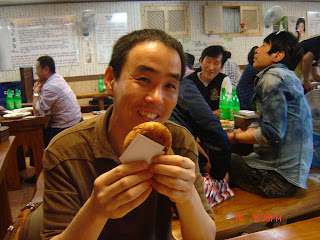Busan4 : More octopus
In Japan, we also eat some octopus. Since the ancient time, we have used a great variety of fish and seafood for our cooking. In fact, we use a whole range of methods to prepare dishes such as filleting, slicing raw ingredients, drying, salting, frying and steaming them. We can say that fish and seafood have been a main dish for a long time, although ideas to have meat as alternatives has gradually become more common in last decades. Yet we still appreciate tasting some robsters, oysters and prawns for special occasions. A strange thing is that we almost never use octopus as main ingredient of a meal. Moreover, we can not even name any dishes associated with an octopus except fast take-away such as "takoyaki". (But this cannot be considered as a meal, anyway.)
Visiting Busan for a few days, the largest fishing port in Korea, I have already found more octopus dishes than Japan. Here are some more examples:
Bibimbap with octopus cooked in a heated stone bowl / 石焼たこビビンバ
We can say that bibimbap is one of national food of Korean and it represents their culinary culture. It is rice prepared with various toppings, dried seaweed, carrot, green pepper and meat (or seafood). There are two types: One is served in a sliver bowl in cold. The other is served in a heated stone bowl. The one I had here is the latter one. I like it more because it is very tasty.
Once it is brought to your table, you mix the ingredients thoroughtly with a spoon. Be careful not to touch any part of the bowl. It is in a scorching HEAT.
While you are doing this process with great care, the heated bowl cooks the ingredients. So, the taste of this dish is largely dependent on your meticulous work. When you do so, some part of rice becomes dry and crispy while the other remains soft and humid.
When you complete it, the bowl is not too hot to touch. Then you can start to eat.Next dish is hotpot dish.
Spicy octopus hot pot / 韓国風蛸鍋 ・ ナッチポックン(낙지볶음)
In most restaurants, hot pot dishes can be ordered at minium of two people. So, if you drop in a restaurant on streets alone, you are most likely to be refused. If you still want this kind of dishes, the best place is at large shopping complex or department stores. And remember to avoid food courts. For example, I went up to the 10th floor of Lotte Department where restaurants are. A dish is served in a small pot like the picture below:
Again, you must mix the ingredients thoroughly.
Now, you can see how the dish like.
Normally, when you order a dish, it is accompanied by five or six sidedishes including a small bowl of white rice. Since I am not accustomed to eat such many sidedishes and relatively small portion of white rice, I asked a waitress for exchanging four sidedishes to another bowl of rice. Since I do not know much Korean, regretably I probably offended her by explaining it not in a good manner. Anyway, I succeeded.
I put two bowls of rice into the pot. Then I mixed the ingredients thoroughly. It was very tasty.

_001.JPG)
_002.JPG)
_003.JPG)
_001.JPG)
_002.JPG)
_003.JPG)
_004.JPG)
+(%EB%A7%89%EA%B1%B8%EB%A6%AC)_003.JPG)
+(%EB%A7%89%EA%B1%B8%EB%A6%AC)_004.JPG)
_001.JPG)
_002.JPG)
_001.JPG)


+_001.JPG)
+_003.JPG)
+_005.JPG)
+_007.JPG)
+_012.JPG)
+_013.JPG)
+_003.JPG)














+(%ED%8C%8C%EC%A0%84)_001.JPG)
+(%EC%B0%8C%EC%A7%90)_001.JPG)






+002.JPG)

_001.JPG)